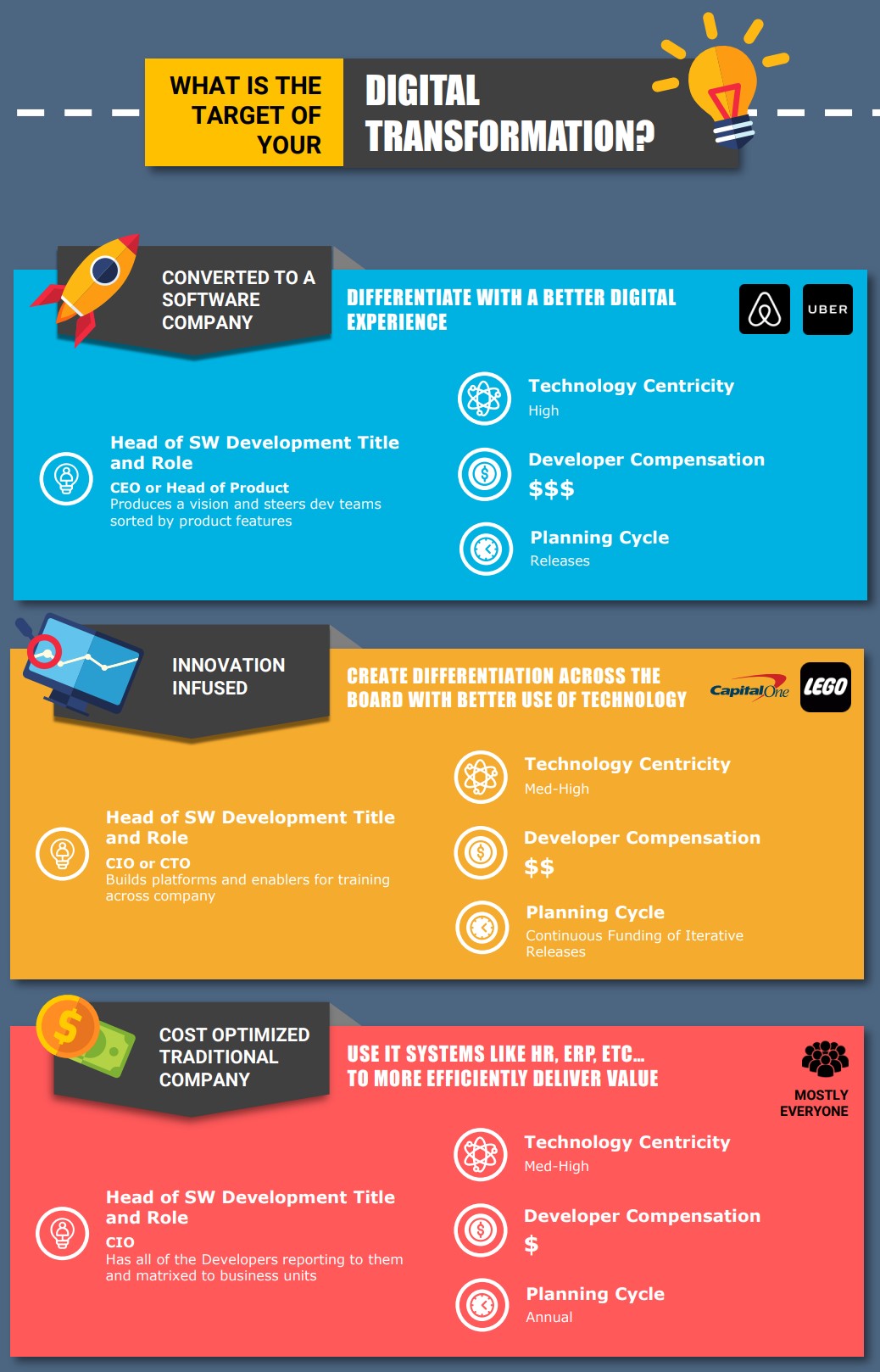Ten years ago, everyone was talking about industries getting “Ubered.” The expectation was that every company would be a software company in a very short order. The question at the time was, “Could you become a software company faster than a software company becomes you?” Ten years later, we’re not all software companies; the big banks are still the big banks (despite a couple of little digital banks), Ford still makes cars, and Tesla still looks like a car manufacturer more than a software company. Do you run or work in IT for a company that never became a software company? The good news is you’re still a company, and I think the risk of getting “Ubered” is low. The bad news is that you still need a Digital Transformation.
Over the last five years, I’ve seen that successful Digital Transformations vary across industries and companies. The key to determining what will make you successful is knowing what differentiates you from your competitors and then figuring out how technology can enhance your USP (unique selling proposition). My observation is that when companies do this introspection and plan a Digital Transformation based on what works for them, they fit into three patterns (see the infographic above):
- They convert to a software company.
- They Infuse Innovation across the company.
- They optimize the cost of technology by managing it as a cost center.
As a technology consultant, I want to believe that everyone’s Digital Transformation will be a game changer, but as an automobile enthusiast, I know better. A great example of a company whose digital transformation would likely only provide incremental value is Ferrari. They famously make their cars by hand, so improvements to the manufacturing process are likely to be small. Ferrari owners don’t expect to interact with their car or the dealership over an app. They will benefit from a digital transformation, but it will be more cost-saving and efficient than game-changing tech. If they don’t already, they’ll want to implement an off-the-shelf ERP system to help them efficiently manage their supply chain, inventory, and distribution. I’m sure there are some -intensive parts of the car and the race teams, but those will likely be point solutions. Overall, for their core business, IT will feel more like a support function (HR, Finance, etc…) that needs to be optimized than a differentiator, even after their digital transformation.
It is the companies in the middle that are most interesting. These companies do not become software companies, but they infuse technology into every portion of their business to create a more differentiated product. Take, for example, a bank like Capital One. As a bank with branches, tellers, and loan officers, they cannot simply “become a software company.” While I have not worked closely with Capital One, a quick perusal of their website shows that they have talented software development teams working on the mobile experience, software for the branches, and credit cards. My guess is that talented software teams can be found in every corner of Capital One’s business, but unlike AirBnB or Uber, Capital One (and almost any bank) can’t just be software. A large part of their differentiation will be in how friendly their tellers are, what types of financial products and companies they invest in, and so on. A company like Capital One should make the goal of their digital transformation to become “Innovation Infused.” Companies like this should use their Digital Transformation to accomplish three key tasks:
- Invest in infrastructure and development platforms that the different technology teams throughout the company can leverage to create this innovation efficiently. (I posted an article about infrastructure platforms here based on a talk I did at the AWS Summit, and there are a lot of great articles on creating Internal Developer Platforms, like this one).
- Note that this should include rolling out low-code and no-code platforms as well as best-of-breed SaaS solutions that can be configured for differentiation. Companies are increasingly finding ways to stand out with software, even if they don’t code it all.
- Build data platforms and AI tools that allow Data and AI to be effectively integrated into many of these separate development teams. Too many companies have all of their data engineers and data scientists in one team that is separated from the real business problems. Similar to the infrastructure and development platforms I spoke about above, your data needs to exist in a platform where APIs, queries, and standard models for ingestion/governance are available to engineers throughout the organization.
- Change the way you think about projects! Build out teams that know their customers and focus on products. These teams can be spread across the company, but to maintain a strategic vision at the company level, it is important that there is some consistency (Usually formed from an Agile CoE or Agile PMO). It is also critical that companies change their budgeting and planning mechanisms to support this product transformation. For advice on how to be successful on this item, I highly recommend the book Lean Enterprise.
Over the last couple of years, my team and I have carved out significant expertise in this middle category of companies. While the threat of getting “Ubered” never materialized in most industries, the need to “Infuse Innovation” via software development will become paramount over the next decade. I’ve worked personally with a leading airline, a leading electricity company, and several financial companies that understand this and are making tremendous progress. Helping people and companies infuse innovation into what makes them great has become my overall goal.
